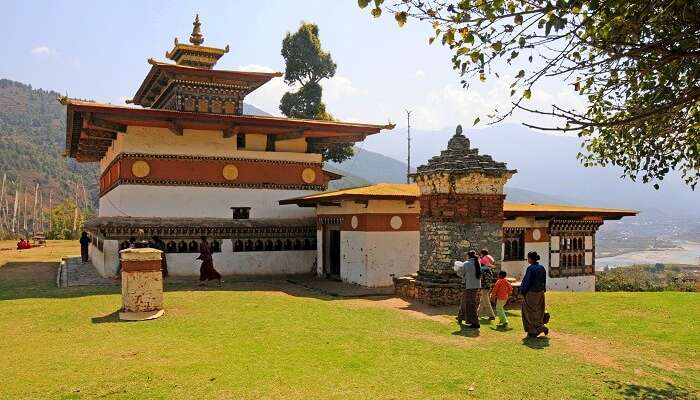Punakha is located in the scenic and fertile valley in-between the confluence of the Mo Chhu (Mother River) and Pho Chhu (Father River). And, bang – in the center of the river junction is the gorgeous Punakha Dzong – perhaps one of Bhutan’s most impressive fortresses.
The low altitude of the valley allows for paddy to be grown and harvested twice a year, and fruits of all hues are in abundance. Bird lovers should keep their eyes peeled for the critically endangered white-bellied heron, which can be spotted in Punakha valley. Of the global population of only 200, around 34 are in Bhutan.
The drive from Thimphu to Punakha is quite spectacular as the road meanders through the renowned Dochula Pass, which offers the awe-inspiring opportunity to view the great Himalayan Mountain Ranges.
Driving down from Dochula towards Punakha, visitors can discover the Royal Botanical Park, where an excellent collection of Himalayan plants and good birding sites can be found.
The drive from Thimphu to Punakha is quite spectacular as the road meanders through the renowned Dochula Pass, which offers the awe-inspiring opportunity to view the great Himalayan Mountain Ranges.
Driving down from Dochula towards Punakha, visitors can discover the Royal Botanical Park, where an excellent collection of Himalayan plants and good birding sites can be found.
Places of interest in and around Punakha:
1. Punakha Dzong:

Standing majestically at the confluence of the Pho Chhu and Mo Chhu rivers, the dzong (fortress) was constructed in 1637-38 and is the second oldest dzong in the Kingdom. The dzong houses the sacred relics of the southern Drukpa Lineage of the Kagyu school of Tibetan Buddhism, including the Rangjung Kasarpani and the sacred remains of Ngawang Namgyal and the terton Pema Lingpa. It was the administrative centre and the seat of the Bhutanese government until 1955, when the capital was moved to Thimphu. Today, it is still the winter residence of the Je Khenpo (Chief Abbot) and the monastic body of Bhutan. Set against a spectacular backdrop, the architecture of the dzong is simply awe inspiring. It was in Punakha dzong that the wedding of His Majesty King Jigme Khesar Namgyel Wangchuck and Her Majesty Queen Jetsun Pema was held on October 13, 2011.
2. Chimi Lhakhang:

Of all the religious figures of Bhutan, perhaps no one is as popular as Drukpa Kunley or The Divine Madman. The maverick saint was so revered that a temple – Chimi Lhakhang (translating to ‘Temple of the Divine Madman’) was built in his honor. Legend has it that Lama Kunley subdued a demon of the region with his ‘magic thunderbolt of wisdom’ and trapped it in a rock close to where the Lhakhang now stands. He was known as The Divine Madman for his unorthodox ways of teaching Buddhism often with sexual overtones. He is also the saint who advocated the use of phallus symbols that even today adorn Bhutanese paintings and houses. The Lhakhang is believed to bless couples who seek fertility and children. The monastery is the repository of the original wooden phallus that Drukpa Kunley brought from Tibet. It is used to bless people who visit the temple on pilgrimage, particularly women seeking blessing to beget children.
3. Talo Village:
The village of Talo sitting at an altitude of 2,800m is scattered along the slopes of a hill and is famed for its cleanliness and hygiene. Also, the women of Talo are particularly known for their striking good looks. The Talo Goenpa, in the snowy peaks, overlooks the Punakha valley as it sits on a mountain ridge. For centuries this ancent spiritual center has stood guard over the valley below. The monastery was founded in 1767, in the year of the fire pig, according to the Bhutanese calendar.
4. Nalanda Buddhist College:

Nalanda Buddhist Institute also known as Dalida or Daley is a Buddhist Drukpa Kagyu School situated in the western region of the Punakha Valley. In the native language the word “Nalanda” stands for endless knowledge. The college was founded in 1957 by the 9th Je Khenpo Shakya Rinchen. For visitirs, Nalanda Buddhist Institute with its religious and historic influence has become one of the must visit places in Punakha Valley.

No comments:
Post a Comment